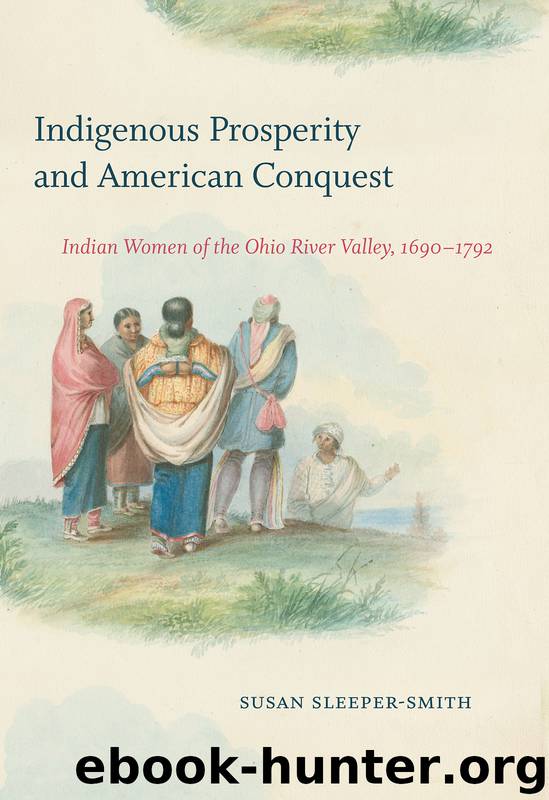Indigenous Prosperity and American Conquest by Sleeper-Smith Susan;

Author:Sleeper-Smith, Susan;
Language: eng
Format: epub
Publisher: Omohundro Institute of Early American History & Culture
Published: 2018-03-12T16:00:00+00:00
OUIATENON
1. Clothing 55.04
2. Hunting 20.08
3. Cooking & eating 7.22
4. Alcohol 6.95
5. Adornment 5.62
6. Woodworking 2.25
7. Grooming 1.24
8. Tobacco use 1.20
9. Digging/cultivation .10
10. Amusements .08
11. Weapons .02
12. Fishing .01
13. Maintenance —
GREEN BAY
1. Clothing 65.08
2. Hunting 18.09
3. Cooking & eating 4.59
4. Alcohol 4.37
5. Adornment 2.95
6. Woodworking 2.39
7. Tobacco use 1.61
8. Grooming .87
9. Weapons .19
10. Digging/cultivation .07
11. Maintenance .06
12. Fishing .03
13. Amusements .01
Source: Susan Sleeper-Smith, Indian Women and French Men: Rethinking Cultural Encounter in the Western Great Lakes (Amherst, Mass., 2001), 126, after Dean L. Anderson, “The Flow of European Trade Goods into the Western Great Lakes Region, 1715–1760,” in Jennifer S. H. Brown, W. J. Eccles, and Donald P. Heldman, eds., The Fur Trade Revisited: Selected Papers of the Sixth North American Fur Trade Conference, Mackinac Island, Michigan, 1991 (East Lansing, Mich., 1994), 107.
The distinctive clothing styles fashioned from trade cloth earned women respect and admiration within their villages. Clothing was highly prized and passed down from one generation to the next. Although we cannot identify these women by name, their tribal identity or clan membership is often evident from the specific embellishments of the moccasins they created. Women created distinctive clothing styles, and everyday items, such as leggings, breechcloths, shawls, and dresses, were transformed through their intricate designs. They acquired the knowledge associated with clothing manufacture: some became proficient in embroidery and cutwork, whereas others relied on beadwork and quillwork to enhance the beauty of their clothes. Any one or a combination of these features transformed cloth into striking designs. Dress was distinctively fashioned to reflect both status and authority for the wearer as well as the creator. These ornate forms of dress were apparent during ceremonial occasions, when different types of cloth were reserved for specialized varieties of dress. In the Midewiwin, which spread throughout the Great Lakes in the eighteenth century, women fashioned elaborate dress for mide priests, accessorizing it with beadwork sashes, bandoliers, and shoulder bags to symbolize their office and power. Elaborate dress was also worn by the candidates and described by Joseph Nicollet when he attended an Ojibwe Midewiwin ceremony in 1837.
The candidate, man or woman, will make his appearance dressed in the richest, the most beautiful and classical costume of his sex in line with the customs of his nation. A stranger cannot but admire the taste and artfulness revealed by the Chippewa in their way of reconciling elegance with the customs and requisites of modesty and decency.… To them [the Chippewa], these celebrations are a matter of national pride for which men and women prepare themselves long in advance.16
Download
This site does not store any files on its server. We only index and link to content provided by other sites. Please contact the content providers to delete copyright contents if any and email us, we'll remove relevant links or contents immediately.
| Civilization & Culture | Expeditions & Discoveries |
| Jewish | Maritime History & Piracy |
| Religious | Slavery & Emancipation |
| Women in History |
Cecilia; Or, Memoirs of an Heiress — Volume 1 by Fanny Burney(32441)
Cecilia; Or, Memoirs of an Heiress — Volume 2 by Fanny Burney(31875)
Cecilia; Or, Memoirs of an Heiress — Volume 3 by Fanny Burney(31858)
The Secret History by Donna Tartt(18865)
Sapiens: A Brief History of Humankind by Yuval Noah Harari(14258)
Leonardo da Vinci by Walter Isaacson(13190)
The Radium Girls by Kate Moore(11935)
Sapiens by Yuval Noah Harari(5297)
How Democracies Die by Steven Levitsky & Daniel Ziblatt(5134)
The Wind in My Hair by Masih Alinejad(5036)
Homo Deus: A Brief History of Tomorrow by Yuval Noah Harari(4828)
Endurance: Shackleton's Incredible Voyage by Alfred Lansing(4685)
The Silk Roads by Peter Frankopan(4461)
Man's Search for Meaning by Viktor Frankl(4437)
Millionaire: The Philanderer, Gambler, and Duelist Who Invented Modern Finance by Janet Gleeson(4386)
The Rape of Nanking by Iris Chang(4141)
Joan of Arc by Mary Gordon(4023)
The Motorcycle Diaries by Ernesto Che Guevara(4020)
Hitler in Los Angeles by Steven J. Ross(3902)
